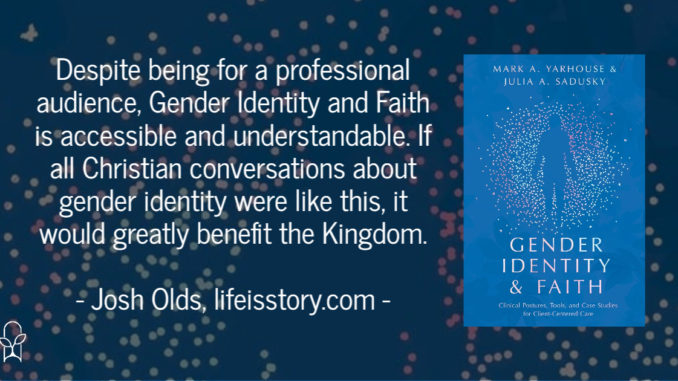
Also by this author: Listening to Sexual Minorities: A Study of Faith and Sexual Identity on Christian College Campuses
Published by IVP Academic on May 3, 2022
Genres: Academic, Non-Fiction
Buy on Amazon
Goodreads

Helping people navigate gender identity questions today is complex and often polarized work. For clients and families who are also informed by their faith, some mental health approaches raise more questions than answers. Clinicians need a client-centered, open-ended approach that makes room for gender exploration while respecting religious identity. Gender Identity and Faith carves out clinical space for mental health professionals to help people who wish to take seriously their gender identity, their religious identity, and the relationship between the two. Drawing from their extensive research and experience with clients, Mark Yarhouse and Julia Sadusky provide a timely, practical resource for practitioners. This book
emphasizes respect for clients' journeys, without a single fixed outcome, toward congruence between their gender identity and faith describes effective clinical postures, assessment and therapeutic tools, and numerous case studies covers needs and characteristics of children, youth, and adult clients includes worksheets and prompts for clients and family members Integrating personhood and values is no easy feat, especially in our current cultural landscape, the authors write. Those navigating this intersection need clinicians who seek to understand their unique context and journey with them with empathy. This book helps point the way.
A 2021 Ipsos poll found that Gen Z individuals were four times as likely to identify as transgender, nonbinary, gender-fluid, or some other genderqueer categorization. Gender identity has become part of the culture wars with battles being fought in the courts and in society about gendered sports, bathrooms, and more. There’s a lot of vitriol, a lot of ignorance, and a lot of unhelpful dialogue. What can we do better? How are we to act as people of faith?
For years now, Mark Yarhouse has been at the forefront of the Christian discussion on sexuality and gender. As director of the Sexual and Gender Identity Institute at Wheaton, his academic focus has been to create a compassionate and helpful structure for Christian therapists and counselors to discuss sexual and gender identity with those who come to them for help. Gender Identity and Faith: Clinical Postures, Tools, and Case Studies for Client-Centered Care is an academic work geared toward therapists and other professionals, but also has value for those in ministry and laypeople wanting to learn more about diverse gender identities.
The book is divided into four sections. The first provides an overview of gender identity in therapy and how to assess gender identity in a therapeutic setting. In particular, they advocate really listening to the individual, asking them to provide a narrative account of their story. Getting people to tell their story often helps the clinician understand the client’s motivations, the length of time they’ve felt a certain way, and why they’ve felt that way. A couple of things where I think Gender Identity and Faith could have done better would have been to acknowledge that not all diverse gender identities are dysphoric. Gender dysphoria describes a sense of unease due to a difference between biological sex and sociological gender. Not all individuals have this sense of unease or locate that sense of unease within themselves. Yarhouse and Sadusky would have done well to better delineate, or at least mention, the sociocultural constructs of gender and how that plays into dysphoric feelings or feelings of gender diversity (i.e. One does not fit cultural stereotypes of a certain gender, therefore they must be gender diverse.)
The second part deals with therapy postures when it comes toward children. Yarhouse and Sadusky, correctly in my estimation, advocate for what they call “gender patience” and do not usually recommend the use of puberty blockers. For them, this is too big of a decision based on a child’s understanding of gender and/or sexuality and the long-term effects of puberty blockers are yet unknown. While this goes against the trend in current secular therapy, Gender Identity and Faith carefully lays out their position and reasoning and I find it compelling. I do wish that they had talked about instances in which prepubescent gender confirmation surgery is appropriate, such as in cases of intersexuality.
The largest part of the book is spent on therapy tools for adolescents and adults. Yarhouse and Sadusky intersperse their clinical advice with vignettes and case studies, offering real-life examples of how to provide care for those working through gender identity issues. Through this section, they show that gender dysphoria or genderqueer identity comes in many ways and in many different contexts. There cannot be a “one size fits all” answer because individuals are, well, individual. The fourth part of the book is an appendix of sorts that provides clinicians with some larger case studies.
Despite being for a professional audience, Gender Identity and Faith is accessible and understandable. Yarhouse and Sadusky treat the topic compassionately and with nuance, even—perhaps especially—when they diverge from mainstream secular thought. Anyone who might be in a position to work with transgender or genderqueer individuals, particularly adolescents, will highly benefit from this book. I especially appreciated the advice for dealing with parents of children or adolescents expressing a diverse gender identity. If all Christian conversations about gender identity were like this, it would greatly benefit the Kingdom.
